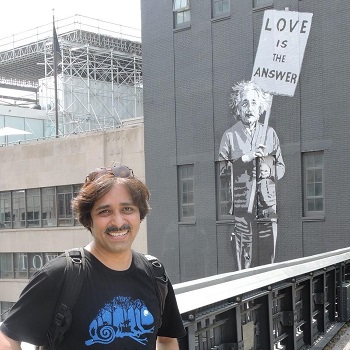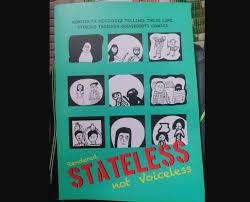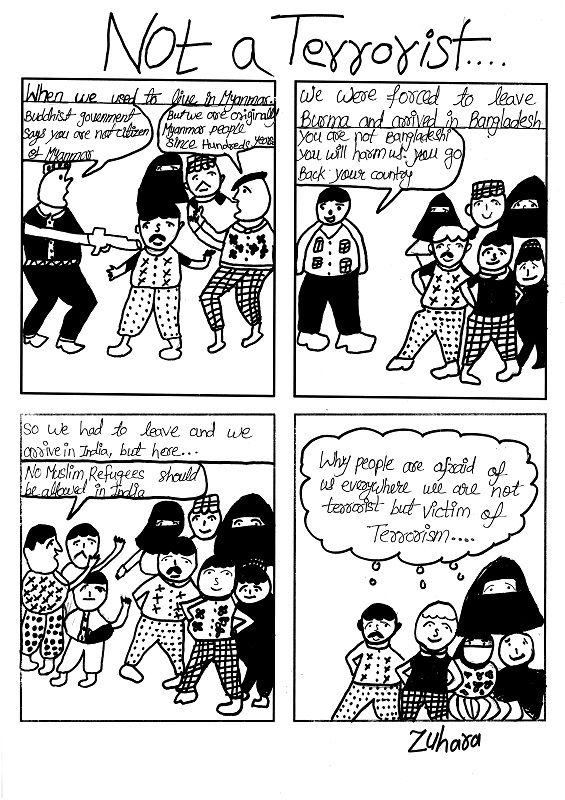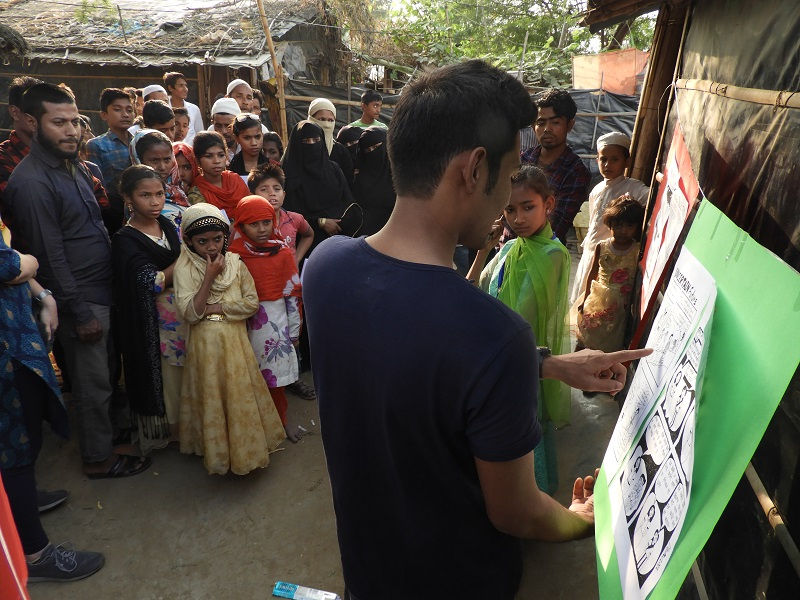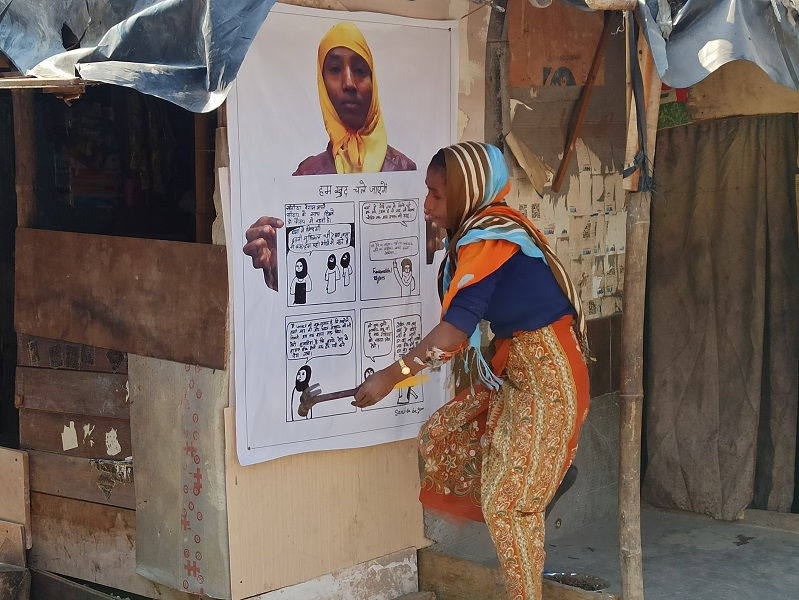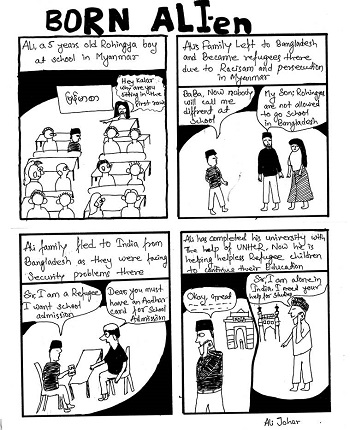Interview with Sharad Sharma regarding “Rendered Stateless: Not Voiceless” — comics created by Rohingya refugees
Sharad Sharma is a Delhi based cartoonist and comics trainer. More than twenty years ago he started the grassroots comics movement. It has now spread across the globe. He has taught a wide variety of people — be it a vegetable vendor or homeless person. His aim is to teach how easy it is to draw comics to tell one’s life story. The slogan is ‘Any Body Can Draw,’ (The ABCD of Grassroots Comics). It has proved to be a powerful alternative medium of communication. According to Sharad Sharma, “The grassroots comics are different from mainstream comics created by professional artists, they are creations of common people having no as such artistic ambition but a burning desire to express their own self or share their point of view. The simplicity of the grassroots comics approach lies in the fact that it just requires a pen, paper and something to say.” He adds, “We believe that the process of a grassroots comics workshop is much more important than the final product. The workshops are not just for simply imparting or acquiring drawing skills, but rather focus on how participants can develop an eye for an issue. They learn how to identify the stories, which really matter to them and are close to their heart. They are shown different ways and examples of how to compose an idea, develop a story around it or just tell their life stories or even start by sharing any small incident. This participatory method promotes the sharing of each individual’s ideas that are then discussed among participants, leading to debate inside the workshop hall and later in society.”
Recently Sharad Sharma conducted a workshop with the Rohingya refugees in India. Some of the stories were published in Rendered Stateless: Not Voiceless. The stories have been collected according to the following themes: The Exodus and Aftermath; Amenities beyond reach; Fight for Rights; Health Hazard; Languishing language; Mission Education; Past-Tense Present-Tense; Struggle for Survival; Usual Suspect and Uncertain Future. There are translations in English of each comic strip at the bottom of the page. The stories documented are heart-breaking. Suddenly it becomes evident that when people are stateless, with no documentation to their name, they have no identity and then access to very basic amenities or education became a hurdle. The goal of this project was to help Rohingya refugees to document their life stories back in Myanmar as well as their current struggle for survival in India. Although a good number of media reports have been published on their condition in India but there are no instances when they themselves were provided an opportunity to express their concerns. Telling your life story to others no doubt is a healing process by itself, but what makes this process more interesting is when the same thing is done with the help of a medium like grassroots comics. Here you neither require your audience in front of you nor seek their immediate response. One has a choice to either reach out to a selected audience after producing the final wall poster-comic by reproducing it through photocopy or make it available in public domain for larger reach.
Sharad Sharma says “The exodus of around one million Rohingyas from Myanmar was an unprecedented crisis, especially for South East and South Asian regions. As per the United Nations High Commissioner for Refugees (UNHCR), 17,500 Rohingya refugees are registered in India, although according to some claims these numbers are as high as 40,000. The work of the UNHCR to protect their rights becomes more difficult as India is not a signatory to the 1951 Refugee Convention. Government of India terms Rohingyas as ‘illegal immigrants’…” (Sharad Sharma, “Rendered Stateless, Not Voiceless”, Timesnow.com, 5 March 2020.)
The stories are narrated so simply that even a child can comprehend. My ten-year-old child remarked, “I have read some of this book. I really liked it. It is about refugees. They are very truthful and the refugees are not scared of telling the truth and they are telling their story to people on how they experienced this life and how much pain they have and how they were discriminated against and they were not scared of what might happen to them — because if the people who hurt them might find out about this book but the refugees are not scared, they are brave, because they have faced enough violence, lost everything else, so they may as well tell their story unafraid.”
Here are excerpts of an interview with Sharad Sharma:
- How did this project happen?
I was in touch with few youth activists from the Rohingya communities since 2014 and was keeping a close eye on their issues both in India and other parts of the globe. In last two years there was a plan to do this project but there was no financial support available then. In 2011, I did a similar workshop with the political refugees from the Burma, there were around 8-10 thousand Burmese refugees were living in west Delhi (non-Rohingya). In the beginning of the current project I showed them comics produced in previous workshop by other Burmese refugee and that was very encouraging and helped to generate lots of interest among these participants.
- How long did it take, including the workshop?
It took almost 8 months to complete the project. But the groundwork was going on for almost a year.
We organised two workshops:
- Kalindi Kunj refugee camp, New Delhi (14-15 Sept 2019): This camp came into existence on 20 May 2012. Approx. fifty Rohingya families live here. Total population = 225. Most of the people earn livelihood as daily wage labourers, running small shops and stalls, or ply rental e-rickshaws.
- Nangali-1 Camp, Nuh, Haryana (16-17 Nov 2019): There are several small settlements of Rohingyas in Haryana. This camp consists of fifty-one families. Total population = 156.
The experience was overwhelming.
From Delhi Workshop
This feeling of the “ownership of the Comics medium” – that is my story ¬told in my way – was felt throughout the room when the participants were asked to draw their own stories. With blank sheets and pencils in their hands, the participants were asked to draw any story they want to share. Minutes into the process, multiple stories and narratives began to emerge on each new sheet. “This is my school, back in Myanmar!” “This is me and my friends, going on the road. These are the trees back in Burma!” “This is me, and my sisters and this is our home!” “Here we are stopped by Burmese police and not allowed to go since we don’t had any permit”
With the idea of taking the discussion further, participants were shown comics from a workshop held ten years back with the other Burmese refugees (non-Muslims). Some of them enjoyed reading Burmese language comics after a long gap. The translators in the room helped in communicating the stories in Rohingya language to those who might not understand the Hindi-English bilingual description. What truly sparks the discussion further with these comic stories is when participants say, “This has happened to us too!”, “We go through this as well!” “Wait, isn’t this what happened to us too!?”
The comics illustrated how some experiences and stories are common and unite people in their shared sense of struggle and hope. Issues such as bad healthcare, harassment in homes and public spaces, exclusion and discrimination.
From Nuh (Mewat) workshop
A ten by thirty feet bamboo shack located at one corner of the settlement now being used as an informal school-cum-Arabic classroom was selected as our hub for next two days grassroots comics intervention. An exhibition of the comics posters developed in earlier workshops was displayed outside the hut. Although 30 persons registered for the workshop but only few of them turned up on time as we were told by the local coordinator Jafarullah that people are both shy and scared of drawing. Once the exhibition was put up, a discussion on the stories and objective behind the programme started that encouraged many to join. New electric bulbs were bought to light the dimly lit hut. Soon the hall was full of kids, youth and elderly, but wait…where are the women? With some effort finally 5-6 women joined the workshop.
As soon as a drawing session on facial expressions began, participants started enjoying the session and their fear of drawing became a thing of the past. All were excited to see stories developed by the residents of the camp in Delhi about their daily life and hardships of the past. Now they too were eager to share their own stories.
One after other participants started telling stories of their past, communities and harsh life in the refugee camps, struggle for survival, language barrier, lack of empathy and fear of being deported. Since the workshop was happening in the middle of the camp it became the centre of attraction for all the kids who camped all the time at the gate of the workshop venue. The women that had joined the workshop late, picked up the concept fast and started writing and doodling their stories on the paper. The electricity was quite irregular hence technicalities of the comics making was explained outside in front of the exhibition. One of the youth leaders of Rohingya community Ali Johar interpreted everything in local language. At the end everyone was assigned homework of creating rough pencil drawing based on their stories.
The day two started with great enthusiasm, participants were already at their seats and eager to share what they had drawn last night. The most curious were two elderly Azizullah (70) and Md Tayyab (65) who contrary to my expectation drew their stories overnight. They were keen to show it to me as if they wanted to make sure if what they did was on the right track. A large number of them consisted of children who had very little patience and were also competing with each other at the same time. Apart from this there were two major hurdles, one was language and the other, illiteracy. Most of the Rohingyas were well versed with conversational Hindi but unable to read and write it. While the other challenge was that the new generation, born and brought up in India, is not familiar with Rohingya language. Interesting challenges but these were overcome with the assistance of the school students who helped others write their dialogues. There was a clear camaraderie visible around that no one should be left behind and everyone was helping others.
Since the women also have household responsibility they were getting restless as the time passed, many of the kids especially girls came to their rescue and started helping them finishing their comics at the earliest.
As if the cold weather and dim light in the shack were not enough, we started facing frequent power cuts at the end of the day, a sign that the hardships for Rohingyas are never ending.
One of the participants Sadiq Khan was so impressed with this idea that next day he brought his daughter to the workshop. Even when there was no electricity the father daughter duo switched on their mobile phones torch and continued to work on their comics without complaining.
While we collected all the final artwork, there were many kids who asked for white paper as they were interested to draw more now.
- How did you invite the refugees to participate?
Through the local organisation Rohingya Human Rights Initiate, which is a youth led organisation, we got access to their camps.
- Do you have to have a preliminary session on oral histories and how to convey that which is pertinent? How does it work?
Most of the refugees are very tied up with their work and not in the position to spare much time for the workshop, our goal was to get their struggle for the survival in India and journey from Burma to here. The initial storytelling session helped them to understand how to pick only that important aspect and share relevant stories, rather telling everything about their life. Our format and time doesn’t allow that.
- What have you done with the original artwork?
It is with World Comics India, but in most of the workshops we return it to the creators. May be someday we will use them to exhibit it at some platform. (due to NRC agitation in the country we had to drop those plans). We printed big flex with photos of some of the participants holding their comics and it was hung in their camps during the launch of Rendered Stateless: Not Voiceless. The book was also launched in one of their camp.
- What were the ideas and conversations that were shared and said in the workshop that could not be converted into a comic strip?
There were some participants who shared some good stories but couldn’t come on the second day to complete /convert it into a comic. Some of these stories were about their life back home, some about difficulties in getting work in India. One of the area we wanted to focus on their mental health issue, which was not possible to discuss in detail due to sensitivity and also time constraint. One of the girl has created one such story about her mother.
- What was the age range of participants?
From 8 to 70 years.
- Do you see a difference in response depending upon the gender of the artist/contributor?
In Delhi women were more active as they were frequent to the workshop venue (it was an organisation close to their camp and teach their kids).
- How do you ensure that the refugees are free to express themselves and are not self-censoring or mindful of authorities? How do you gain the participants confidence?
Many of the stories they shared about their fear on NRC, government plans to send them back home and their expectations from Indian authorities – all this was shared without any hesitation. Even the stories of exodus they shared willingly. They had faith in us, as RHI activists were present during the workshop. In fact, the activists had introduced us to the participants at the venue. At times they acted as interpreters of the Rohingya language. This was also for the first time that they got a chance to share their ordeal with someone, the idea of documenting these stories on their own/ or their own way was very exciting to them.
- Do such specific engagements with Rohingya refugees require you to research substantially to map the landscape before the project commences? Or do you plunge straight into the workshop encouraging the participants to express themselves?
I was in touch with them since long and reading a lot about their issues. Visited their camps in Khajuri Khas and other areas before the workshop, interviewed youth, children to get a sense of the situation.
22 May 2020

